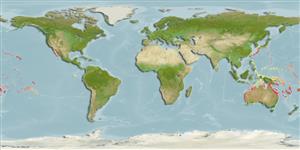>
Blenniiformes (Blennies) >
Tripterygiidae (Triplefin blennies) > Tripterygiinae
Etymology: Norfolkia: Named for the Norfolk Island ( In 1953 Henry W. Fowler named this new genus on a Collection of Fishes Made by Dr. Marshall Laird at Norfolk Island) (R.Bajol, pers.comm. 04/2016)..
More on author: Whitley.
Environment: milieu / climate zone / depth range / distribution range
Ecologia
marinhas associadas(os) a recifes; intervalo de profundidade 1 - 20 m (Ref. 13227). Tropical
Western Pacific: Western Australia in the eastern Indian Ocean to New Caledonia, Rapa, the Tuamoto Archipelago and Mangaréva.
Tamanho / Peso / Idade
Maturity: Lm ? range ? - ? cm
Max length : 5.0 cm SL macho/indeterminado; (Ref. 54980)
Descrição suscinta
Morfologia | Morfometria
Espinhos dorsais (total): 18 - 19; Raios dorsais (total): 9-11; Espinhos anais 2; Raios anais : 20 - 22. Scales from head posteriorly to behind the eye but none on cheek; lobate supraorbital tentacle; body coloration white; yellow or orange on scale edges; 6 uneven, oblique, dark brown bands bifurcating ventrally; uneven brown bar below eye with white posterior border; females with thin, oblique, red and white bands on second and third dorsal fins; dull orange in males. Dorsal rays IV + XIV-XV + 9-11 (typically XV + 10); pectoral rays usually 15; lateral line discontinuous, 12-15 + 24-27; mandibular pores 3 + 2 + 3 (Ref. 54980).
Adults are found in coral reefs and intertidal pools (Ref. 13227). Eggs are hemispherical and covered with numerous sticky threads that anchor them in the algae on the nesting sites (Ref. 240). Larvae are planktonic which occur primarily in shallow, nearshore waters (Ref. 94114).
Ciclo de vida ou comportamento de acasalamento
Maturidade | Reprodução | Desova | Ovos | Fecundidade | Larvas
Fricke, R., 1994. Tripterygiid fishes of Australia, New Zealand and the southwest Pacific Ocean (Teleostei). Theses Zool. 24:1-585. (Ref. 13227)
Status na Lista Vermelha da UICN (Ref. 130435)
Ameaça para os humanos
Harmless
Uso pelos humanos
Pescarias: sem interesse
Mais informação
Nomes comunsSinônimosMetabolismoPredadoresEcotoxicologiaReproduçãoMaturidadeDesovaAgregação de desovaFecundidadeOvosDesenvolvimento dos ovos
Idade/TamanhoCrescimentoPeso-comprimentoComprimento-comprimentoFrequências de comprimentoMorfometriaMorfologiaLarvasDinâmica larvalRecrutamentoAbundânciaBRUVS
ReferênciasAquaculturaPerfil para aquaculturaEstirpesGenéticaElectrophoresesHereditariedadeDoençasProcessamentoNutrientsConversão de massa
ColaboradoresFotosStamps, Coins Misc.SonsCiguateraVelocidadeTipo de nataçãoÁrea branquialOtólitosCérebrosVisão
Ferramentas
Relatórios especiais
Baixar XML
Fontes da internet
Estimates based on models
Preferred temperature (Ref.
123201): 23.3 - 28.6, mean 26.6 °C (based on 778 cells).
Índice de diversidade filogenética (Ref.
82804): PD
50 = 0.5625 [Uniqueness, from 0.5 = low to 2.0 = high].
Bayesian length-weight: a=0.00562 (0.00258 - 0.01228), b=3.08 (2.89 - 3.27), in cm total length, based on LWR estimates for this (Sub)family-body shape (Ref.
93245).
Nível Trófico (Ref.
69278): 3.2 ±0.4 se; based on size and trophs of closest relatives
Resiliência (Ref.
120179): Elevada, tempo mínimo de duplicação da população menor que 15 meses (Preliminary K or Fecundity.).
Fishing Vulnerability (Ref.
59153): Low vulnerability (10 of 100).
Nutrients (Ref.
124155): Calcium = 319 [147, 835] mg/100g; Iron = 1.63 [0.72, 3.16] mg/100g; Protein = 18.3 [16.9, 19.7] %; Omega3 = 0.102 [0.039, 0.282] g/100g; Selenium = 45.1 [13.2, 133.4] μg/100g; VitaminA = 63.8 [14.5, 286.2] μg/100g; Zinc = 3.74 [2.00, 6.14] mg/100g (wet weight);
